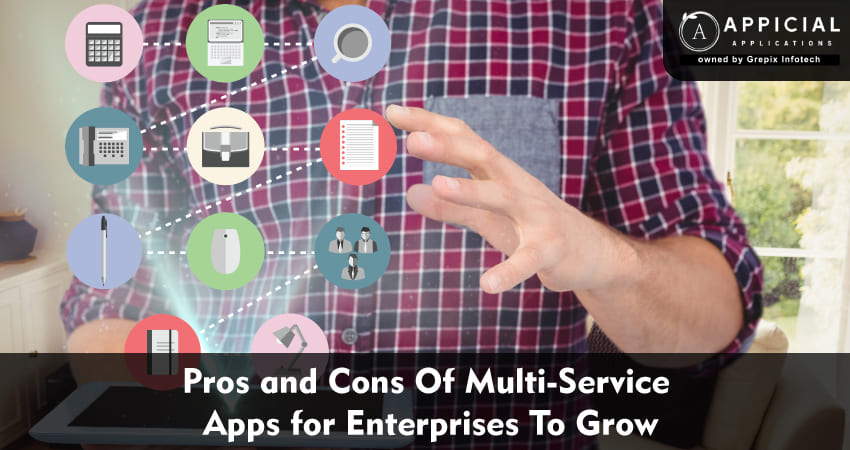
Pros and Cons Of Multi-Service Apps for Enterprises To Grow
In the era of digital transformation, multi-service apps have become a cornerstone for enterprises aiming to diversify their offerings and enhance customer engagement. These apps serve as a one-stop solution, offering a plethora of services ranging from on-demand delivery to financial services, all under one umbrella. While they present a lucrative opportunity for growth, it's imperative for businesses to weigh both the advantages and disadvantages before diving in. Here's a closer look at the pros and cons of multi-service apps for enterprises looking to expand.
This blog delves into the advantages and drawbacks of multi-service apps for enterprises seeking growth. It highlights the benefits, such as enhanced customer engagement, cross-selling opportunities, streamlined operations, brand reinforcement, and valuable data insights. However, it also cautions against challenges, including the complexity of development and maintenance, increased competition, resource allocation difficulties, regulatory and compliance issues, and the risk of diluting brand focus. The conclusion underscores that while multi-service apps offer significant potential for business expansion and customer convenience, success requires careful strategic planning, substantial investment, and a focus on delivering value to maintain customer trust and brand integrity.
Pros
1. Enhanced Customer Engagement
Multi-service apps provide a platform for businesses to offer varied services to their customers, ensuring higher engagement levels. By catering to multiple needs through a single app, enterprises can ensure more frequent interactions, fostering a stronger customer relationship
2. Cross-Selling Opportunities
These apps open up avenues for cross-selling, allowing businesses to introduce customers to a wider range of services. This not only boosts sales but also enhances customer retention as consumers find more value within the same application.
3. Streamlined Operations
Consolidating services into one app can lead to more streamlined operations and reduced costs. It simplifies the management of services, inventory, and customer support, providing a more efficient way to handle business processes.
4. Brand Reinforcement
Offering multiple services under one brand name strengthens brand recognition and loyalty. Customers who are satisfied with one service are more likely to try another if they come from the same trusted brand, thereby reinforcing the brand's value.
5. Data Insights
Multi-service apps offer rich data on customer preferences and behavior across different services. This data is invaluable for tailoring offerings, improving customer experience, and making informed business decisions.
Cons
1. Complexity in Development and Maintenance
Developing a multi-service app involves intricate planning, coordination, and investment. The complexity increases with each added service, requiring robust technology infrastructure and a skilled team to maintain smooth operations.
2. Increased Competition
Entering multiple service domains means facing competition from established players in each of those fields. Standing out in crowded marketplaces requires significant marketing efforts and innovation.
3. Resource Allocation Challenges
Balancing resources across different services can be challenging. There's a risk of spreading too thin and not being able to meet the quality standards or deliver the value promised to customers.
4. Regulatory and Compliance Issues
Operating in multiple service sectors can complicate regulatory compliance. Enterprises must navigate a maze of laws and regulations that may vary significantly from one service to another.
5. Risk of Diluting Brand Focus
There's a fine line between diversification and dilution. Offering too many services without a clear synergy can confuse customers and dilute the brand's core identity.
Conclusion
In conclusion, multi-service apps present a double-edged sword for enterprises aiming to expand their operations. On the one hand, they offer a consolidated platform for delivering various services, enhancing customer engagement, streamlining operations, and potentially leading to increased revenue and market share. They represent a forward-thinking approach to meeting the evolving needs of consumers, who favor convenience and efficiency in accessing multiple services through a single application.
In the other hand, the development and maintenance of such complex platforms can be resource-intensive, requiring significant investment in technology, skilled personnel, and continuous innovation to stay competitive. Additionally, enterprises must navigate the challenges of maintaining high-quality service across diverse offerings and ensuring data security in a landscape where consumer trust is paramount.
Ultimately, the decision to adopt a multi-service app strategy should be guided by a thorough analysis of the enterprise's capabilities, market demand, and long-term strategic goals. For those able to overcome the inherent challenges, multi-service apps can be a powerful tool for growth and differentiation in a crowded marketplace. However, success in this endeavor demands a commitment to excellence, adaptability, and an unwavering focus on delivering value to the customer.





